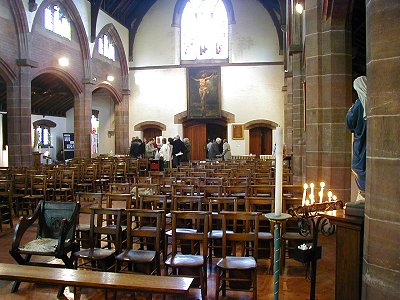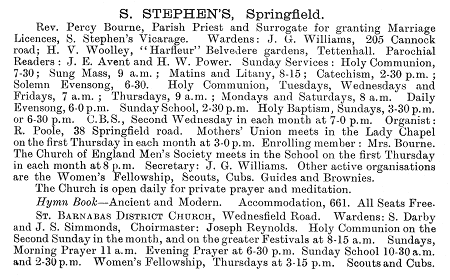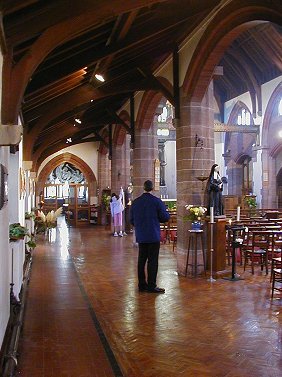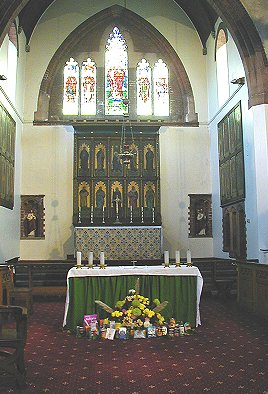|
The Post
War Years
In 1948 the Rev. William Hassall
accepted a post at St. Faith’s Parish Church, Merseyside
and was succeeded at St. Stephen’s by the Rev. Percy
Bourne. |
|

The Lady Chapel. |
During his time at the church many improvements took
place starting with the Chancel Scheme, which raised
£1,200 for the installation of light oak choir stalls
and communion rails. |
More stained glass windows were fitted and the
improvement programme over the next few years included
the following:
| 1949 |
The church
interior was cleaned and redecorated. |
| 1950 |
The addition of a
wrought iron chancel screen. |
| 1951 |
New carpets and
curtains. |
| 1952 |
14 stations of the
cross installed. |
| 1952 |
Land acquired for
the building of a church hall. |
| 1953 |
New communion
rails fitted. |
| 1954 |
A silver cross
purchased for the high alter. |
| 1955 |
2 clergy stalls
fitted. |
| 1957 |
Electric radiant
heaters installed in the Lady Chapel. |
| 1957 |
Installation of
new choir stalls. |
| 1958 |
The east window from St. James’ Church
fitted in the west wall.
|

Another of the beautiful
windows.
|
| 1952 was a good year for fund raising. The church’s
summer fete was held at Butler’s sports ground in
Springfield Road.
The highlights included cycle racing, stalls,
sideshows, and a display by St. Stephen’s youth club.
Help was on hand from the brownies and girl guides and
members of the public were admitted for 1 shilling.
The event raised a total of £272.16s.0d. towards the
cost of building a church hall. |

The Nave. |

From the 1958 Wolverhampton Red
Book.
|
In 1955 St. James’ Church closed
and as a result the St. Barnabas part of St. James’
parish was added to St. Stephen’s parish to form the
United Benefice of St. Stephen.
By 1956 the church was finding it
difficult to meet the financial demands of the school,
and so during that year the school managers were obliged
to make an application for controlled status. The 1944
Education Act enabled church schools to choose between
aided status, controlled status, or to become
independent. |
|

Looking towards the Lady Chapel. |
Up until now St. Stephen’s school
had been an aided school where the church was greatly
involved in the running of the school and had a majority
representation on the governing body.
The school governors employed the
staff and were responsible for building extensions and
external repairs, for which they received a percentage
reimbursement from the local education authority. At the
time plans were in hand for the building of an essential
new school, at an estimated cost of £65,750, which was
too great a financial undertaking for the church.
The application for controlled
status would enable the new school to be built with
state funding. The local education authority would
become responsible for the school’s finance, and the
church would have a minority representation on the
governing body. |
|
The Rev. Percy Bourne retired on 18th
December, 1958 and was replaced by the Rev. Francis
Vincent Seaborn who started his duties on 4th
September, 1959. During the same month Mr. Charles
Harrison became the church’s honorary treasurer.
On 12th February, 1961 a
Christian stewardship scheme was introduced at the
church and before the year ended, work at last began on
the church hall, built by Bailey and Smith. By August
1962 the building had been completed and on 27th
August it was officially opened as the Percy Bourne
Memorial Hall. Around this time volunteers from the
church began visiting people in the local community.
This started in 1961 when visits were made to the
residents of the newly built flats, and continued in
1962 as the Good Neighbours Scheme which involved
regular visits to 72 old people in the vicinity. This
led to the Wednesday Afternoon Club which met weekly in
the church hall. |
|
In 1964 the church’s organist and
choirmaster Mr. William Stevens-Ingley and his wife Mary
founded a new cub pack, and on 27th December,
1964 the Rev. Francis Vincent Seaborn conducted his last
Sunday service at the church before his departure to
Longton. He was replaced in July 1965 by the Rev. John
B. B. Samuels.
The church celebrated its diamond
jubilee in 1968, and during March 1970 the Rev. Samuels
moved to Adbaston. His successor, the Rev. Roy G. Davies
started his duties in July. By this time the new St.
Stephen’s School on Long Ley had been completed. It
opened its doors for the first time in September 1970.
During the late 1960s funds were in short supply and
St. Barnabas’s mission church was in a bad state of
repair. It only had a small congregation and so the
decision was taken to close the mission church, the last
service being held there on the 20th
December, 1970. St. Barnabas’s was sold to the New
Testament Church of God in 1971 for £8,750. |

The alter. |
| Some of the internal fittings such as the alter and
the credence table were given to the chapel at Brinsford
Lodge, thanks to the efforts of the Rev. Geoffrey Wynne,
chaplain of the Polytechnic. Also in 1971 changes took
place in the parish boundaries between St. Stephen’s and
Heath Town, although the changes were not confirmed
until 1973. As a result of the changes St. Stephen’s
acquired the area between Nine Elms Lane and Prosser
Street along the northern side of Cannock Road.
When the new St. Stephen’s School opened, the old
church school in Grimston Street closed, but only
remained so for about a year. In 1971 overcrowding at
the new school led to its reopening as a school annexe,
and the church’s first annual summer fete was held, and
raised a total of £253. |
|

A final view of the church. |
During the 1970s a number of
changes took place in the clergy. On 2nd
July, 1972 the Rev. David Wood became assistant curate,
but sadly he died in November 1975 and was succeeded by
the Rev. Michael Slack. A memorial to David Wood in the
form of the Lady Chapel alter frontal was designed by
Laurence King. In June 1976 Michael Slack resigned to
join the Roman Catholic Church.
In 1978 the cub pack began to hold
meetings in the church hall and the former Woden Road
Primary School became St. Stephen’s Day School.
The last vicar of St. Stephen’s
retired in 1992 and the living was suspended. As a
result the Rev. John Oakes, vicar of St. Martin’s Church
became priest in charge at St. Stephen’s in March 1993.
|
|
St. Stephen’s Church now attracts worshippers from all
over the City, including former members of other
churches such as St. George’s Church, and Christ Church,
both of which have closed. As a result its influence now
extends well beyond the Springfield area. Hopefully it
will have a long and successful future. |
 |
|
 |
Return to
World War 2 |
|
Return to the
beginning |
|